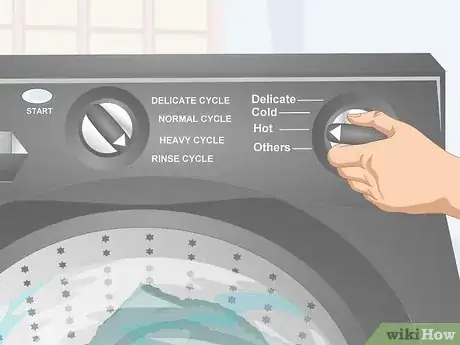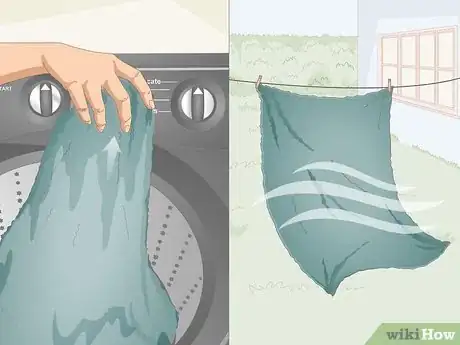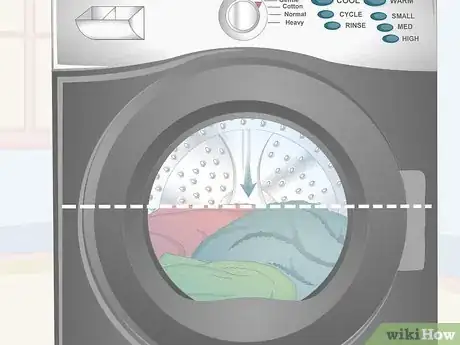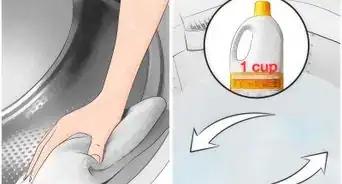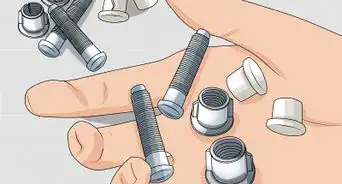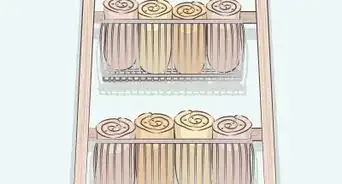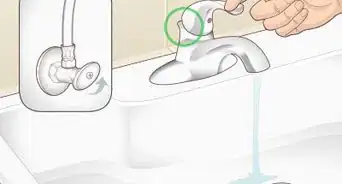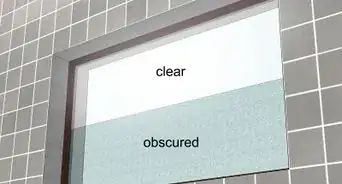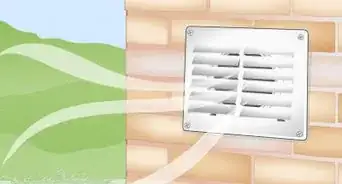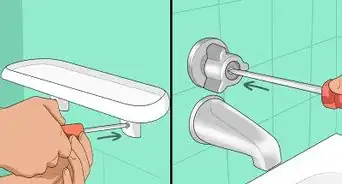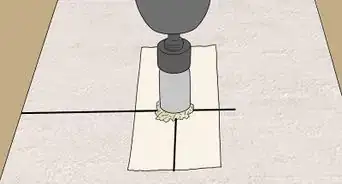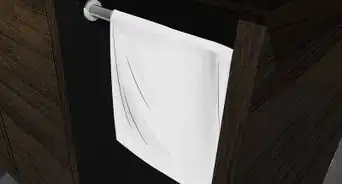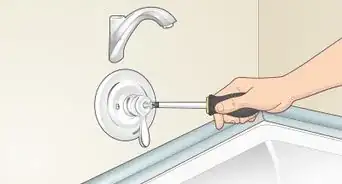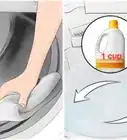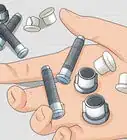This article was co-authored by Kadi Dulude. Kadi Dulude is a House Cleaning Professional and the Owner of Wizard of Homes, a New York City-based cleaning company. Kadi has over 10 years of experience and manages a team of over 90 registered cleaning professionals. Her cleaning advice has been featured in Architectural Digest and New York Magazine.
There are 7 references cited in this article, which can be found at the bottom of the page.
wikiHow marks an article as reader-approved once it receives enough positive feedback. This article received 13 testimonials and 95% of readers who voted found it helpful, earning it our reader-approved status.
This article has been viewed 853,666 times.
Fluffy, fresh towels feel great when you dry off with with them, but often they seem to just be moving water around your body instead of soaking it in. This is because towels at the store have often been treated with fabric softeners, which have water-repelling oils as ingredients.[1] Breaking in new towels to make them absorbent can take a while, but with a few washes in hot water before use and better laundry habits, your towels will quickly be ready to dry without any hassle.
Steps
Removing the Fabric Softener from New Towels
-
1Load the new towels into an empty washing machine. Don't stuff the machine with a full load of new towels. You don't want to overload your washer, so try to keep the amount of towels in one wash to about half of a load.[2]
- Don't wash anything else with the new towels because colors may bleed.
- If you have a variety of light and dark towels, create separate loads so the dark towels don't bleed onto the light towels.
-
2Start a rinse cycle with hot water and let the machine fill completely. Hot water will break down and wash off the fabric softeners that towel manufacturers use to make towels feel fluffy in the store. Make sure they are completely submerged so that the entire towel soaks in the water.[3]Advertisement
-
3Add 1 cup (240 mL) of white vinegar to the hot water. Vinegar aids the hot water in the breakdown of the fabric softeners. Plus, it also helps to make your towels soft without leaving an oily residue on them.[4]
- Be careful not to get the hot water on your skin, as you could hurt or burn yourself!
-
4Let the washing machine go through a complete wash cycle. A regular full cycle will include rinse and spin cycles. After the full cycle ends, there should be no water left in the washer. Your towels will probably smell of vinegar, but that's okay![5] The vinegar scent will dissipate during the next wash.
-
5Begin a second wash cycle without drying your towels first. Do not take your towels out of the washing machine to dry them yet! Instead, leave them in the washer and let it fill up with hot water again. Use the same settings that you used the first time.
-
6Add 1/2 cup (120 g) of baking soda to the second wash cycle. Add the baking soda when the washing machine is completely filled with water. When the baking soda mixes with the small amount of vinegar that is still on the towels, it will produce a chemical reaction, neutralizing any leftover vinegar and getting rid of detergent or fabric softener that is stopping your towels from being absorbent.[6]
- Do not mix the vinegar and baking soda in the same wash cycle! This will cause a large chemical reaction that will probably lead to a big, foamy mess and could cause damage to your laundry machine.
-
7Take the towels out of the washing machine and dry them. You can dry your towels as you normally would. You can use any method that you like—your dryer, a drying rack, or air drying in the sun.
Keeping Towels Absorbent
-
1Avoid using fabric softeners when washing your towels. Even though fluffy towels are something most people enjoy, the fabric softeners used to get fluffy towels can leave behind hydrophobic oils that repel liquids, which means they won’t be very absorbent. Not using fabric softeners stops this from happening.[7]
- If you still want the softest towels you can get, there are ways to soften them without the use of fabric softeners.
- If you want to use fabric softeners on your other laundry, just wash your towels in a separate load.
-
2Use half as much detergent when doing loads of laundry with towels. Detergent, like fabric softeners, can leave oils on your towels that repel liquids. Using only half as much as you normally use will dilute the detergent in the water just a little more and help to make your towels more absorbent, and your laundry will still be clean.[8]
- Using less detergent is also a good way to save a little money!
-
3Do half-sized loads of laundry when you wash your towels. Overloading your washing machine means that any detergent you do use won’t distribute evenly across the laundry. Take the amount of laundry you planned to do in one load and divide it into two equal piles so that you have two loads. Consider doing loads of only towels instead of throwing them in with other laundry.[9]
- Your towels won't be washed as thoroughly if you're using large loads, ultimately causing them to be less absorbent.
Community Q&A
-
QuestionWhat can I use to replace fabric softener?
 Community AnswerPut two rubber dryer balls (old tennis balls work, too––just make sure they're clean!) in the machine with the towels when drying them. This will help to fluff up the towels and they will then be more absorbent.
Community AnswerPut two rubber dryer balls (old tennis balls work, too––just make sure they're clean!) in the machine with the towels when drying them. This will help to fluff up the towels and they will then be more absorbent. -
QuestionHow do we recondition a slippery bathing towel into the scratchy towel it was before?
 Community AnswerTry line-drying it in the sunshine and fresh air rather than in a tumble dryer. The slipperiness is probably a result of too much fabric softener, so once it's been washed a few times without this it should regain its absorbent qualities.
Community AnswerTry line-drying it in the sunshine and fresh air rather than in a tumble dryer. The slipperiness is probably a result of too much fabric softener, so once it's been washed a few times without this it should regain its absorbent qualities. -
QuestionDo I use soap when I wash the towels?
 Community AnswerYes, as you want your towels to still smell fresh without that sandy smell.
Community AnswerYes, as you want your towels to still smell fresh without that sandy smell.
Things You'll Need
- Washer and dryer
- Vinegar
- Baking soda
- Laundry detergent
Warnings
- Do not use vinegar and baking soda in the same rinse. The chemical reaction will create lots of frothing, which can cause damage to your washing machine or make a big mess.⧼thumbs_response⧽
References
- ↑ https://www.washingtonpost.com/lifestyle/home/how-to-have-the-softest-towels/2019/03/25/c886563a-4a59-11e9-b79a-961983b7e0cd_story.html
- ↑ https://youtu.be/COlOGb4suMI?t=29s
- ↑ https://www.cnet.com/how-to/this-one-washing-trick-will-make-your-old-towels-feel-like-new/
- ↑ https://www.cnet.com/how-to/this-one-washing-trick-will-make-your-old-towels-feel-like-new/
- ↑ https://www.cnet.com/how-to/this-one-washing-trick-will-make-your-old-towels-feel-like-new/
- ↑ https://www.unoriginalmom.com/review-refresh-your-towels/
- ↑ https://www.goodhousekeeping.com/home/cleaning/tips/a19506/fabric-softener-cleaning-product/
- ↑ https://www.chicagotribune.com/consumer-reviews/sns-bestreviews-bedbath-the-best-towel-set-20190610-story.html
- ↑ https://www.bhg.com/homekeeping/laundry-linens/linens/washing-and-caring-for-towels/

